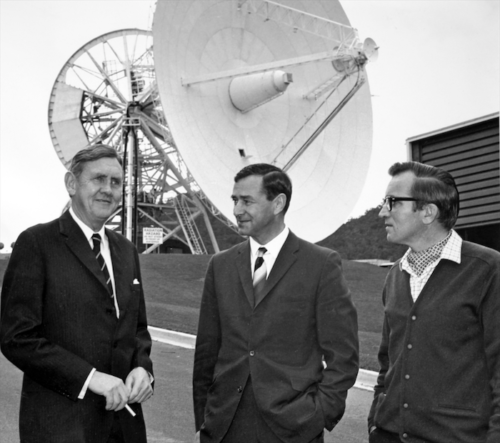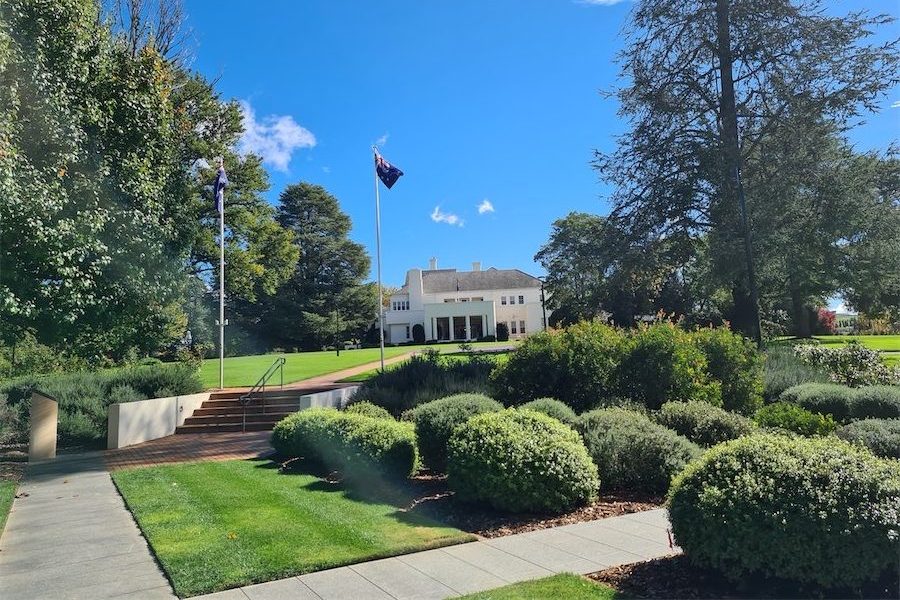
HUNDREDS of millions of people around the world collectively gasped at Neil Armstrong’s first tentative steps on to the lunar surface at 12.56pm Australian Eastern Time on Wednesday, July 21, 1969 – and Canberra was in the thick of bringing those pictures to Earth.
The Honeysuckle Creek Tracking Station, in the ACT, helped bring the pictures to the world until the moon rose over Parkes and, after overcoming a terrible wind, the Parkes dish carried the broadcast for their friends at NASA.
Armstrong emerged from the spacecraft first and while descending, he released the Modularized Equipment Stowage Assembly on which the surface television camera was stowed, and the camera recorded the first step on the moon.
Canberra saw the whole thing unfold milliseconds before the rest of the world. The international broadcast signal, which originated in Australia, had to travel halfway around the world and back again via a satellite over the Pacific, meant Australian audiences witnessed the first steps on the moon – around 300 milliseconds before the rest of the world!
Former ACT Senator Margaret Reid, whose late husband Tom Reid was the director of Honeysuckle Creek, says the tracking station, 37 kilometres south-west of Canberra, had a crucial role in the landing.
“At the time, I don’t think we really appreciated what Honeysuckle Creek Tracking Station had actually done,” she says.
According to Margaret, the magnitude of the event was also unknown to Tom, who she says was just doing his job that historic day.
“His concept for success came from the team work behind it, which he acknowledged greatly,” she says.
Author Andrew Tink confirms this in his book “Honeysuckle Creek – the story of Tom Reid, a little dish and Neil Armstrong’s first step.” (UNSW Press). The NSW politician-turned-author says Reid was often regarded as a prickly Glaswegian unwilling to suffer fools gladly. But it was this no-nonsense attitude that enabled him to form a team of talented technicians.
“I tried to get him to talk about this on a few occasions – tried to get him to open up about what he’d done at Honeysuckle Creek, especially in relation to Apollo 11. But he always changed the subject,” says Tink.
“He absolutely hated, loathed, talking about himself. He was an extremely modest, private person and if he ever said anything about his work, he would always deflect to the team that he led.”
Neil Armstrong’s first steps on the surface of the moon were watched by 600 million people – an amazing audience even by today’s standards. The signals from the moon were received by Honeysuckle Creek and Parkes in NSW.
Signals were relayed to Mission Control in Houston, which initially switched between the sources to try to get the best picture.
Just under 10 minutes after the historic broadcast started, the moon had risen into the Parkes telescope’s full field of view. Parkes was a much larger dish than Canberra’s, therefore it captured more signal and produced better images. US Mission Control then switched to Parkes and remained with those pictures for the rest of the 2½-hour broadcast.
A sample of lunar-surface material was collected and stowed to assure that, if a contingency required an early end to the planned surface activities, samples of would be returned to earth.
Astronaut Buzz Aldrin then joined Armstrong for those pictures of them “bouncing” on the moon’s surface.
The astronauts then carried out a planned sequence of activities that included deployment of a solar wind experiment, collection of a larger sample of material, panoramic photographs of the region near the landing site and the close-up photographs of the lunar surface.
After more than two hours, the astronauts began to re-enter their lunar module and a well-earned sleep. The crew then left, after 21 hours and 36 minutes.
Returning to earth, Apollo 11 entered the atmosphere with an incredible velocity of 36,194 feet per second (11,032 metres per second), dropping in to the Pacific Ocean.
Who can be trusted?
In a world of spin and confusion, there’s never been a more important time to support independent journalism in Canberra.
If you trust our work online and want to enforce the power of independent voices, I invite you to make a small contribution.
Every dollar of support is invested back into our journalism to help keep citynews.com.au strong and free.
Thank you,
Ian Meikle, editor





Leave a Reply